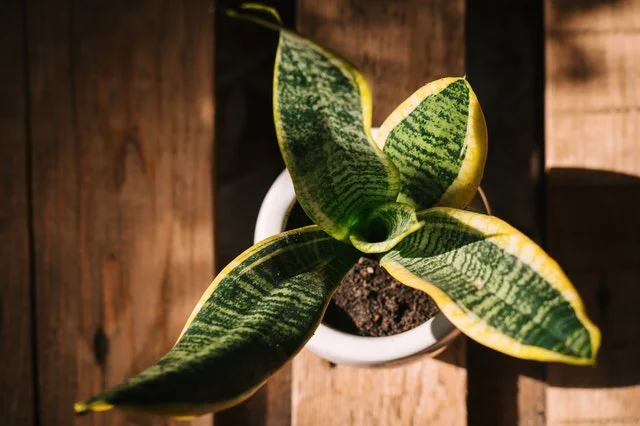If you’ve noticed your snake plant has a bit of yellow on there, that is not a good sign. Here is our guide on making sure that gets sorted as soon as possible.
A snake plant with yellow leaves will usually be bordered by yellow, with yellow stripes throughout the plant.
Yellow is caused by the plant’s inability to renew its chloroplasts, which is usually caused by too much water but can be caused by an infection.
Too much water is likely due to you overwatering it, the wrong size pot, or the environment. You can solve these issues by not overwatering it, putting it in the correct size pot, and changing the environment.
Table of Contents
About Yellow Leaves
What yellow leaves look like
Although most of us will look at “yellow” leaves and see them as, well, yellow, if you were to look a little bit closer, you would see that they’re closer to green. Although it is a much lighter green than a healthy snake plant. In fact, the green is so light compared to a healthy snake plant that many will see it as yellow.
Usually, the yellow will be around the edges. But, there will also be streaks of yellow throughout the plant- some may say it slightly resembles a tiger’s stripes. Even though this might look nice to some of you, it’s not healthy for the plant.
The Science of yellow leaves
Every plant has tiny little things called chloroplasts in its cells. As you may remember from high school biology, chloroplasts are responsible for photosynthesis. And because chloroplasts are green, most plants in nature tend to be green. The only exception is flowers that use other colours in an attempt to attract bees.
When there are fewer chloroplasts in a plant, the shade of green will be much lighter. So, when your plant is turning yellow, it has not been able to repair all of its chloroplasts.
The cause of yellow leaves
The main reason why a plant cannot repair its chloroplasts is too much water.
When the soil has too much water in there, the roots can become clogged up, preventing them from absorbing the nutrients in the soil that help with cell repair.
Since it can’t take up anything from the soil, it will not have the necessary tools to make repairs. And it doesn’t matter if your soil is packed with nutrients or completely barren of them.
Too much water and it damages the chloroplasts.
Causes of yellow leaves
Overwatering
With house plants, the most common reason why they get too much water is that the plant parent overwaters them. Many of us get a plant because we want to learn about responsibility by looking after a living thing.
Part of this includes watering it. And yes, even snake plants need to be watered sometimes.
However, it’s easy to make the mistake of thinking that because you need to water it, you need to water it all the time. And in an attempt to keep your plant hydrated, you may end up doing more harm by giving it root rot.
Wrong size pot
The size of the pot can also impact how much water it has. You need to make sure it’s neither too small nor too large.
In a pot that’s too small, the roots will grow, so they occupy the entirety of the pot. When this happens, the water will not be able to flow away from them, and it will remain stagnant around them. This blocks the roots from the nutrients it needs.
But when the pot is too big, the roots will essentially be suffocated by the damp soil. This can also lead to root rot.
Environment
Plants tend to be incredibly fickle things that need a specific environment to be able to survive. Compared to some other houseplants, the snake plant is actually a rather hardy fella. However, there are environmental factors that can lead to yellow leaves.
The ideal temperature for a snake plant is between 55-85F. Much lower than this, and the water in the cells may freeze. Much higher, and it may evaporate.
You should also avoid having much more than 20% moisture in the air; this can over saturate the soil and act as though you’ve overwatered it.
Pests/Diseases
Although water is the most common culprit of yellow leaves, they can also arise due to pests or diseases.
Some of the most common pests include spider mites and mealybugs.
There are various ways these little critters can find their way onto your snake plant. You might be carrying them with you on your clothes. They could be in the watering can. Or they may even have hitchhiked from another plant you brought.
No matter where they came from, they are horrible things, but there is still a chance of combating them.
Solutions to yellow leaves
How often to water a snake plant
Suppose the problem is that you’re over (or sometimes under) watering your snake plant. In that case, the solution is to figure out how often to water it. Most people will water theirs between every 2 weeks to every 10 weeks.
However, you needn’t use a schedule. Your plant is not clever enough to know that its next watering is coming up, so it needs to quickly use up what it has left.
Instead of a schedule, check the soil to see how wet it is. If the top 2 inches are dry, then you can water it. If it isn’t, put that watering can away!
How to find the perfect pot
When your plant has become rootbound (meaning the roots now occupy the whole pot), it’s time to take it up a size. However, you mustn’t move it to a pot that’s too big.
Each time you report your plant, only move up by one size. And by one size, I mean two inches.
So if a snake plant in a 12-inch pot becomes rootbound, you should move it to a 14-inch pot.
If a snake plant in a 10-inch pot becomes rootbound, you should move it to a 12-inch pot.
The ideal environment
Getting the environment right is also essential.
If your snake plant is in a room with more than 20% humidity, you should try moving it into a different room. If that’s not an option, think about getting your hands on a dehumidifier. These are cheap and small devices that take water out of the air.
They also dislike sudden temperature changes. So keep any snake plants away from drafts, heating units and cooling units. The ideal temperature will be between 55-85F.
And of course, just as with any other plant, it will also need plenty of sunlight.
How to stop infections
If you notice a single yellow leaf, you should cut it off right away. Just make sure to do so with clean tools.
When there is only one yellow life, you should pray that the infection was only on that one leaf, and by disposing of it, you’re preventing it from going to the rest of the plant.
If that doesn’t work, you should try using a fungicide or insecticide. Which one depends on who’s causing your leaves to go yellow.
If that doesn’t work, I hate to be the one to tell you this, but it will be very hard (or impossible) to revive your snake plant. So best start planning the funeral.
How common are yellow leaves?
If your snake plant has yellow leaves, that does not mean you’re a lousy plant parent. Although it probably does mean you’re a fairly new plant parent.
Just like how a dog parent might give their dog more baths than they need, a plant parent is very likely to give their plant more water than it needs. To be honest, I would say this is a right of passage of becoming a plant parent.
It’s the kind of mistake you can learn from.
Other signs of overwatering
There are other signs of overwatering besides yellow leaves. Let’s take a look at a few of them.
- Dried up and wrinkled leaves.
- Soft and mushy stems and/or leaves
- A plant that just refuses to grow anymore.
If you notice any of them, you have probably made a similar mistake to someone with a plant with yellow leaves. Although it could be an infection, the most probable culprit is too much water in the soil, which prevents them from absorbing the essential nutrients.
The solutions to all these problems are the same as the solutions to yellow leaves.
Conclusion
If you have a snake plant with yellow leaves, the first thing I can say to you is don’t worry. And yes, I respect that is much easier said than done.
Chances are, it’s been caused by too much water, probably because you’ve overwatered it too much. Just make sure it’s in a not too moist room, between 55-85F, in a right size pot, free from pests, and of course, know when to put the watering can down!
We hope that now if your snake plant ever gets yellow leaves, you’re going to have a better idea of what you can do about it.
Photo by Dương Nhân from Pexels


